Whenever we see the word “doodle” in the name of a dog breed, we immediately think of thick, rich curls making up their coat. And that is true in a lot of cases, but not always! One of the cutest exceptions to that rule is the Straight Hair Labradoodle, a teddy bear-looking dog that seems like it came from somebody’s imagination and not reality.
These unique dogs draw more from their Labrador heritage than their Poodle heritage — at least when it comes to their appearance — which is why their coats have that shiny, smooth finish that is so often associated with Labrador Retrievers.
The easily recognizable Poodle coat, well known for its beautiful curls and low-shedding, is usually predominant in a lot of Doodle-type dogs, but it’s nowhere to be seen in these particular Labradoodles.
But there is so much more to Straight-Haired Labradoodles than their novelty coat, so we wanted to research everything there is to know about them and compile it into a single article.
If you were on the lookout for a new dog and came across this breed, you are probably curious to know more about them and what it is that makes them so special.
Well, look no further, because this is your ultimate guide to Straight Hair Labradoodles.
What Is A Straight Hair Labradoodle?

Straight Hair Labradoodles are a cross between Labrador Retrievers and Standard Poodles that have inherited more traits from the Labrador side of their family.
They are one of many Labrador mixes, but they have one thing that makes them special.
It is natural for any mixed breed to get more traits from one side than the other, and coat texture is just one of the possible differences. Even within the same litter, puppies can sometimes have different coat textures, colors, patterns or lengths.
But in the case of Labradoodles in particular, what causes them to have either straight or curly hair? And which one is more frequent?
Let’s find out.
Straight Hair Labradoodle vs Curly Hair Labradoodle
Depending on the breeding generation, Labradoodle puppies can be born with a straight or curly coat, and sometimes it can even be in that in-between state that is best described as wavy hair.
Breeders will often try to control the breeding process in order to get one or the other, and it has shown to be relatively successful.
The main culprit for a Labradoodle’s coat texture is the so-called Cu Locus gene. Colloquially known as “the curly coat gene”, its existence will cause a dog to have a harsher, more curly coat.
Why Do Some Labradoodles Have Curly Hair?
The Cu Locus gene is dominant in the Poodle breed and it causes them to have their distinct curly coat. If a Labradoodle inherits this gene from its Poodle parent, it will end up with a curly or wavy coat.
This type of coat is typically low-shedding and hypoallergenic, so many breeders often aim for it in their litters, which is visible in several Doodle types, such as the Goldendoodle or the Australian Labradoodle.
While it is impossible to accurately predict the type of coat an unborn puppy will have, it’s possible to increase the odds of it being curly by applying some well-known breeding techniques, such as backcrossing a Labradoodle with a Poodle.
That might sound a bit confusing now, but we will explain it in simple terms later on in the article. So stay tuned!
Why Do Some Labradoodles Have Straight Hair?
Labradoodles who are born without the Cu Locus marker in their genetic make-up will have a straight coat, much like their Labrador parents. It is a similar situation to that of Straight-Haired Goldendoodles that inherit those traits from their Golden Retriever parents.
The Labradoodles with this type of coat are most often called Straight Hair Labradoodles or Flat Coat Labradoodles.
The chances of getting a Flat Coat Labradoodle in a litter are directly proportional to the percentage of Labrador Retriever DNA, so certain breeding pairs are more likely to result in puppies with this novelty type of coat.
Labradoodle Breeding Generations
There are some key naming customs that we can use to define breeding generations. The letter F stands for “filial” and it means that the dog in question is a mixed breed.
Furthermore, the number next to F signifies the ordinal number of the generation to which it belongs. So, if a Labradoodle is labeled as F1, that means that it’s a first-generation Labradoodle, i.e., a mix between a purebred Labrador Retriever and a purebred Poodle. The Label F2 means that the puppy is a second-generation Labradoodle, etc.
Another important distinction is the letter B, which implies that the puppy was the result of backcrossing. Backcrossing is the practice of breeding a mixed dog — like a Labradoodle — with one of its parent breeds — a Poodle or a Labrador Retriever.
So, for example, if you cross an F1 Labradoodle with a purebred Poodle, the result will be a first-generation backcross Labradoodle, and its generation name will be F1B. You can read more about F1B Labradoodles here.
Similarly, a puppy labeled F2B will be a cross between a first-generation Labradoodle and one of its parent breeds.
Now, let’s use what we’ve learned here and see how it influences the type of coat a Labradoodle will have.
Read Also: Ending The Cobberdog VS Labradoodle Confusion
Which Generation Of Labradoodles Gets A Straight Coat?
In the simplest of terms, the more Labrador Retriever genetic material a Labradoodle puppy has, the more physical traits it will inherit from that parent breed. That much is obvious.
Applying that logic to them being straight-haired, we can conclude that Labradoodles who have a higher percentage of Labrador DNA in their genetic make-up are more likely to be born with a flat coat.
Statistically speaking, F1 Labradoodles and F2 Labradoodles — a second-generation Labradoodle, which is a cross between two F1’s — have the best shot of ending up with straight hair, but there are, of course, no guarantees.
Some breeders practice backcrossing F1 Labradoodles with Labrador Retrievers to increase their odds of a straight coat, but those are extremely rare. When it comes to backcrossing, Poodles are generally the preferred option.
The reason for that is much more simple than you might think. One of the biggest advantages that Poodles have is the non-shedding quality of their coats. That alone makes them one of the most popular dog breeds in the world for producing mixed breeds. Just take a look at some of these adorable Poodle mixes!
Labradoodles normally inherit that trait and crossing them back with a Labrador Retriever puts them at risk of losing it, and that’s why breeders generally avoid doing it.
To give you a better feel of the chances that each Labradoodle generation has of being straight-haired, we have created this chart that shows the DNA percentage of each parent breed in multiple generations.
If you’re not familiar with your Labradoodle’s family tree and you can’t figure out how much Poodle and Labrador DNA it has, there are DNA tests and other types of genetic testing that can help you get very accurate results.
Parent Breed DNA Percentages In Labradoodle Generations
| 1st Parent | 2nd Parent | Poodle DNA | Lab Retriever DNA | |
|---|---|---|---|---|
| F1 Labradoodle | Lab Retriever | Poodle | 50% | 50% |
| F1B Labradoodle | F1 Labradoodle | Poodle | 75% | 25% |
| F1BB Labradoodle | F1B Labradoodle | Poodle | 87.5% | 12.5% |
| F2 Labradoodle | F1 Labradoodle | F1 Labradoodle | 50% | 50% |
| F2B Labradoodle | F2 Labradoodle | Poodle | 62.5% | 37.5% |
| F2BB Labradoodle | F2B Labradoodle | Poodle | 81.25% | 18.75% |
| F3 Labradoodle | F2 Labradoodle | F2 Labradoodle | 50% | 50% |
Can A Labradoodle’s Coat Change From Curly To Straight? Or Vice Versa?
Good question, but the answer is surprisingly simple — nope. As a rule of thumb, a dog’s coat doesn’t change from straight to curly, or from curly to straight, regardless of their genetics.
As they grow up, a Labradoodle’s coat will change from puppy hair to adult hair, and it might even change its color to a certain degree.
Around the time they are six to twelve months of age, they will start permanently shedding their puppy coat and let their adult coat grow out. The new coat is usually slightly harsher than the old one, but its straight/curly texture never changes.
This means that, as soon as Labradoodle pups are born, you can tell what kind of coats they will have for the rest of their lives.
Different Types Of Straight Hair Coats in Labradoodles
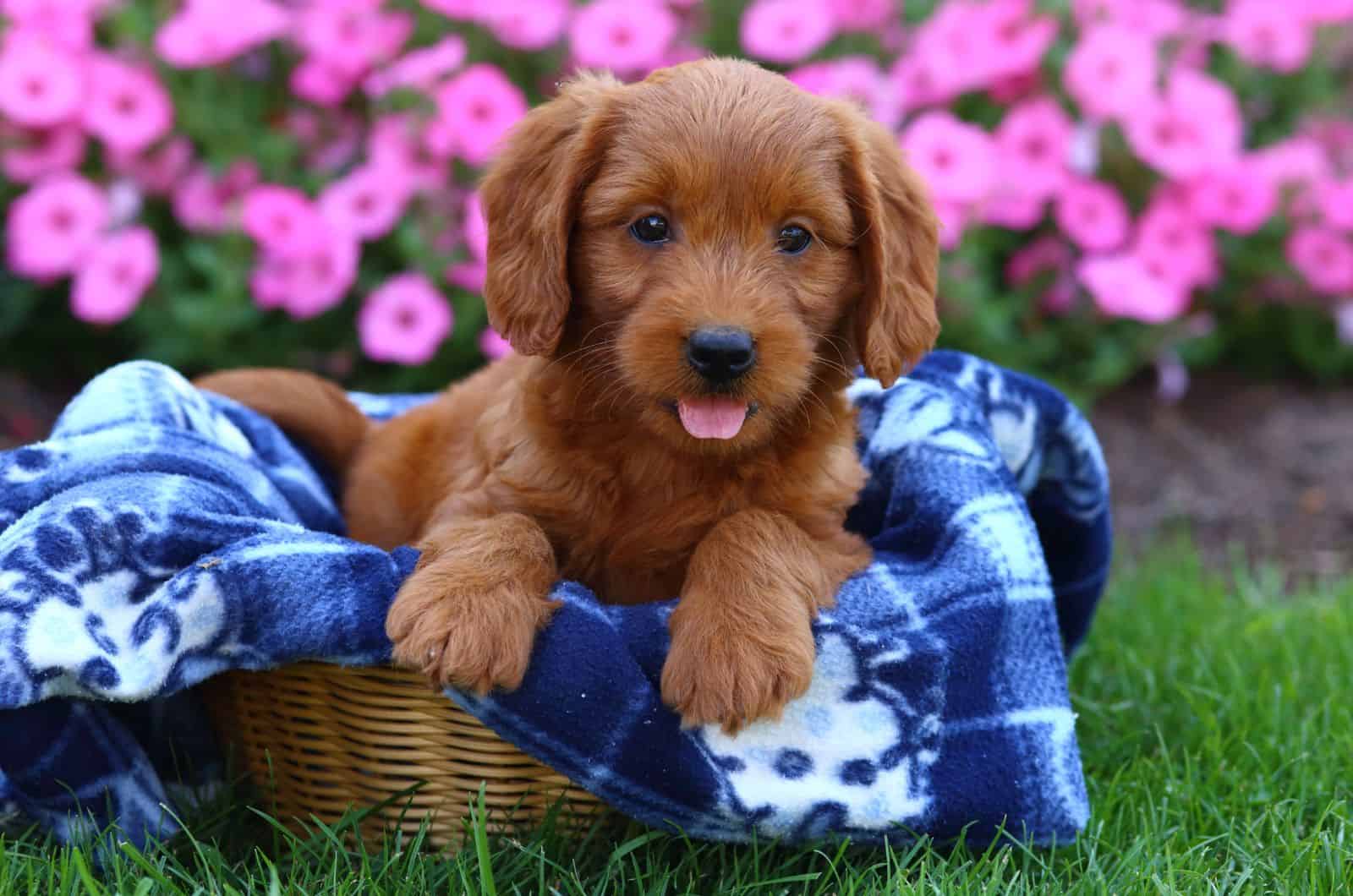
Straight hair coats in Labradoodles are visibly different from curly hair coats, but there are still some variations within this particular type.
Flat coats can have different lengths, patterns and colors, among other things. There isn’t a strict categorization of these differences, but they nevertheless exist, so we wanted to list some of them here.
Straight Coats By Length And Consistency
There are various possible lengths and consistencies of flat coats in Labradoodles, ranging from short to long, from scruffy to slick.
Here is a list of some of the possible options:
• A medium-long coat that is consistent throughout the entire dog’s body
• Scruffy fur with random patches of uneven lengths
• Completely flat and matte coat with consistent length all around
• Slick and shiny coat, reminiscent of Labrador Retrievers in texture
• A completely straight outer coat, but with a short, wavy undercoat
• A coat that is medium-long across most of the body, but with slightly longer feathering along the face, legs and tail
Straight Coats By Color
An interesting thing about Straight Hair Labradoodles is that their coat color — much like the texture — is mostly influenced by the Labrador Retriever portion of their DNA.
This means that they have a similar range of colors as the Labs do. Here are the most common ones:
• Cream
• Chocolate
• Caramel
• Black
• Red
• White
If you would like to see a more exhaustive list of all the different Labradoodle colors, we’ve got you covered.
Can Flat Coat Labradoodles Have Double Coats?

This is a very peculiar distinction, but the short answer is — no, Flat Coat Labradoodles don’t have double coats.
The reason it’s peculiar is that Labrador Retrievers, the parent breed that they most resemble, regularly have a double coat. In fact, their undercoat is very thick and durable, providing them with extra warmth during the colder months.
Poodles, on the other hand, do not have a double coat. They have a single thick coat instead, which is part of the reason why they are a non-shedding breed.
It’s weird how these Labradoodles have inherited so many coat-related traits from Labs, but not this one. At the same time, it is a testament to how strong the Poodle genes are, given that they are the most likely reason for this.
Flat-Coated Labradoodles are almost always single-coated, with perhaps a few exceptions.
And even the exceptions are debatable. As you may have noticed in one of the previous segments of this article, we mentioned that there are Straight-Haired Labradoodles with a straight outer coat and a short, wavy undercoat.
This is not an undercoat in the traditional sense of the word. It’s typically very short and doesn’t always appear evenly spread across the Doodle’s body. More often than not, it comes in patches of fur instead of a consistent, thick coat.
And even if we look past that, these particular Straight-Haired Labradoodles are so rare that it doesn’t even matter in the bigger picture.
Can Mini Labradoodles Have Straight Hair?
Absolutely! Regardless of their size, Labradoodles can have a straight coat if they don’t have the Cu Locus gene.
So, no matter if the Labrador Retriever parent was crossed with a Toy, Miniature or a Standard Poodle, there is a chance that they will be born flat-coated if the necessary conditions are met.
By the way, if you are interested in getting a tiny labradoodle for yourself, regardless of coat type, you can learn more about them in our in-depth article dedicated to Teacup Mini Labradoodles.
Are Straight Coated Labradoodles Hypoallergenic?
Straight-haired Labradoodles are less hypoallergenic than their curly-haired peers. The reason for that is the smaller percentage of Poodle DNA.
Poodles are well-known for being extremely hypoallergenic dogs, while Labrador Retrievers are far from it. Purebred Labs can often be a source of allergies for people who are prone to them, and their coat is known for shedding a lot.
So, Labradoodles that are genetically more like their Labrador Retriever parents, will be a higher allergy risk for people, although not as high as purebred Labs. On the other hand, the Doodles with the highest percentage of Poodle DNA will be the most hypoallergenic.
If we take another look at the chart from before, we will see that those are, in order, F1BB, F2BB and F1B. As you may have figured out due to the letters B in their generation designation, all of these are the result of backcrossing with a Poodle.
Straight Hair Pros And Cons

After going through all of the details of what flat coats are and how they occur in Labradoodles, it’s time to dig into the pros and cons of this coat type.
Weighing up the positives and negatives of Straight Hair Labradoodles is probably one of the easiest ways for all prospective pet owners to make a decision on them. It’s important to know what you’re getting into before adopting a dog, and this is a quick and easy way to compare the two sides of the coin.
So let’s go through all of the pros and cons of flat coats in Labradoodles.
Pros Of Labradoodles With A Straight Coat
We like to start with the good news and leave the bad news for later. So we’re going to discuss the pros first. The positives that we have selected are related to cost, grooming and availability.
1. They’re Cheaper Than Curly-Haired Labradoodles.
When it comes to buying Labradoodles from breeders, typically the most expensive ones are from F1B and F1BB generations. The backcrosses with Poodles are in the highest demand and therefore the most expensive.
Since straight coats usually appear in F1 and F2 puppies, this means that you will most likely get them for a significantly lower price.
2. They Require Less Grooming
The trademark Poodle curly hair can be a chore. You need to constantly take care of it so it doesn’t tangle and to stop it from matting, and you need to cut their hair every once in a while because they don’t naturally shed it.
Coming up with creative haircuts for your Poodle can be fun, but it can also be a tedious commitment.
You can either do this yourself — if you’re feeling confident — or take them to a professional groomer, which costs money and adds up over time.
However, you don’t have to worry about any of this with a Straight Hair Labradoodle. Their hair doesn’t tangle and it sheds regularly, so basically, no trips to the groomer are necessary.
Aside from saving you the hassle, it also saves you thousands of dollars in haircuts over the course of a Labradoodle’s life.
3. There’s Less Competition For Them
Remember how we said that the Poodle backcrosses are in the highest demand in all Labradoodle breeders? The same goes for most curly-haired Doodles, which means that the straight-haired ones will usually be the last ones to get picked from the litter.
So, if you’ve got your heart set on a Flat Coat Labradoodle, you don’t have to worry about missing out or having a bunch of people lining up before you.
4. They Look Like Teddy Bears
This is an extra positive trait that we just had to put in here. Come on, just look at them! How could you possibly resist petting and rubbing them?
Their fleece coats make them look like living, breathing teddy bears, especially when they have that brownish, caramel color, and it’s one of the most aesthetically pleasing looks that a dog can have.
Everybody knows that we love teddy bear dogs here at PupVine! After all, we did make a list of the 27 cutest ones!
Cons Of Labradoodles With A Straight Coat
Here comes the bad news. Unfortunately, as cute as they are, Straight Hair Labradoodles still have some drawbacks. If you plan on getting one, it’s important to know what those are so that you can be prepared.
We have selected three negatives here, and they are connected to their shedding, allergy risks… and more shedding. Let’s take a look.
They Shed A Lot
If you’ve ever owned a Labrador Retriever, you will know how difficult it is to keep the house clean from their stray hairs. That tedious little trait is also passed down to their Straight Hair Labradoodle offspring.
Unlike Labradoodles who are closer to their Poodle parents, the flat coats shed quite often and that requires a great deal of effort from your side. If you keep them inside the house a lot, keeping it clean will be a chore.
It is true that Flat Coat Labradoodles require less grooming in general — especially professional grooming — but you still need to stay on top of their shedding.
Higher Risk Of Allergies
We’ve already talked about hypoallergenic coats, but we think it’s important to discuss it once again in this section.
Poodle genes are the ones that make a Labradoodle’s coat more hypoallergenic, so if they’re straight-coated like Labradors, they will be a bigger source of allergies.
If you or anyone in your home suffers from allergies, perhaps a Straight Hair Labradoodle is not the best choice for a pet. Instead, maybe consider a Doodle with a bit more Poodle DNA, like a Bernedoodle, for example.
You Need To Keep A Brush Close By
We warned you that there will be a lot of talk about shedding. Aside from the problems it can cause when trying to keep your home clean, frequent shedding will also require you to brush your Flat Coat Labradoodle fairly often.
It’s not good for them to leave all that loose hair hanging on their coat, so you will need to have a dog brush at hand to give them a good combing every now and then.
That’s the price of love right there.
How Big Do Straight Hair Labradoodles Get?
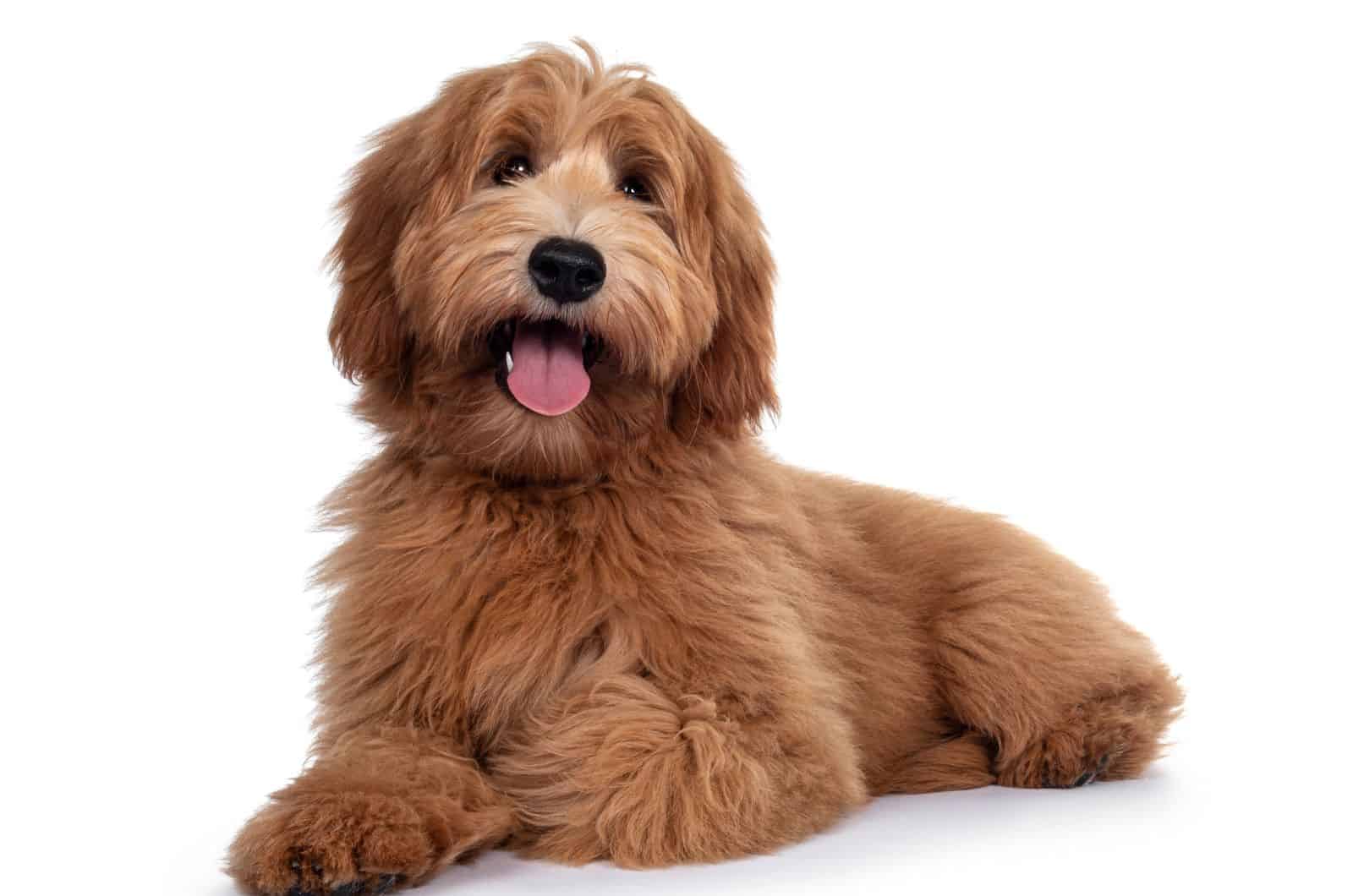
The genetic factors that give these Labradoodles their signature straight-haired coat do not affect their overall size. So, Flat Coat Labradoodles will be about the same size as Curly Hair Labradoodles.
For standard-sized Labradoodles — when a Labrador Retriever is mixed with a Standard Poodle — their height comes up between 20 and 25 inches (51 and 66 cm), and their average weight is about 50 to 100 lbs (23 to 45 kg).
In the case of Mini Labradoodles — when a Labrador Retriever is crossbred with a Miniature Poodle — they only grow up to about 15 to 20 (40 to 51 cm) in height and have an average weight range of 25 to 50 pounds (12 to 23 kg).
The size discrepancy between these two is obvious, and that’s another thing that shows how dominant Poodle genes can be. Mixing practically any dog breed with the Miniature Poodle will result in a small dog. Speaking of which, here are ten great examples of mini Doodle breeds.
Do Straight-Haired Labradoodles Have A Different Personality?
The straight-haired coat itself doesn’t change their personality in any way, but the fact that they have an above-average amount of Labrador Retriever genes in their DNA could signify that they pick up some of their traits, as well.
For example, Straight Hair Labradoodles are very active, high-energy dogs who love the outdoors and being able to play around and explore their surroundings.
They are extremely friendly and playful, which makes them a perfect fit for families with children, as they will be excited to have someone who can match their energy levels and indulge their shenanigans.
If you are a family person and looking for a dog that will suit your needs, here is a list of the 24 best family dog breeds to help you choose your perfect companion.
On the other hand, they might not be as suitable for an apartment in the city as Poodles or F1B Labradoodles are, because they would need you to take them for a walk or to the park multiple times a day.
Straight Hair Labradoodle Grooming Needs
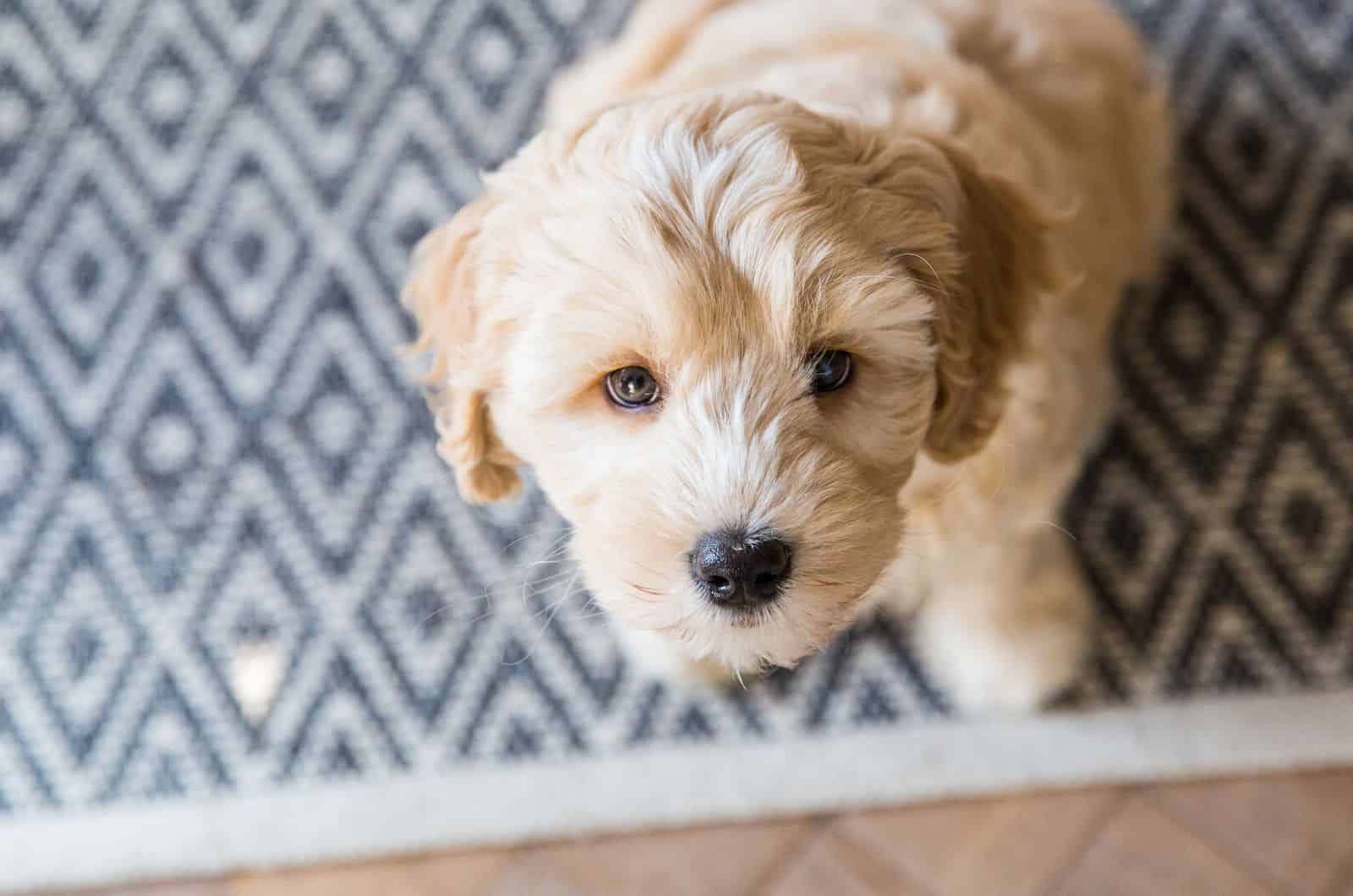
We’ve already discussed a lot of the things that go into the grooming of a Straight Hair Labradoodle, particularly when it comes to shedding and brushing.
But there are still some questions that you might have about that topic, so we wanted to make a special section in the article where we will answer those questions.
What Is The Best Way To Handle Shedding?
Unfortunately, there is no magical one-time solution that will take care of all the headaches that are sometimes associated with shedding. However, there are ways that you can minimize it and stay on top of it.
Here are the three main things that you can do:
Brush Them Regularly
Flat Coat Labradoodles shed more than any other type of Labradoodle, and the best way to counter that is by brushing them regularly.
The more often you do it, the healthier and stronger the remaining coat will be. Try to work the brushing into your routine and make it a bonding time for you and your Doodle.
Eliminate The Stress
Stress is one of the factors that makes dogs shed even more than they normally would. By making their living environment as stress-free as possible, you can significantly lower the amount of hair that they lose and thus make your life much easier.
If you think that your Labradoodle is stressed out, look for possible causes and then remove them from its surroundings.
Feed Them The Right Stuff
Stronger hair follicles will naturally lead to less shedding, and one of the best ways to strengthen a dog’s hair follicles is by feeding them a high-quality diet.
Food that is rich in Omega-3 oils and healthy fatty acids will provide a good foundation for your Labradoodle’s coat to be healthier, stronger and shinier. One example of such an Omega-3-rich food is tuna.
Can I Shave My Straight Hair Labradoodle?
You might be tempted to shave your Straight Hair Labradoodle’s coat off, especially if you want to counter shedding or if you live in a warmer climate and want to make it a bit cooler for your dog.
However, shaving off their coat is a no-no. The coat is actually the thing that protects their skin from getting sunburnt and removing it could lead to all sorts of health problems. The coat is there for a reason.
What you can do is give it an occasional trim. Cutting the excess hair around a Labradoodle’s face, eyes, muzzle and ears will give it a cleaner look, but also help to prevent overheating.
How Often Should I Bathe My Straight Hair Labradoodle?
Bathing is a touchy subject when it comes to dog grooming. When it comes into the house all muddy and wet, you definitely feel the need to give them a good scrubbing down, but in general terms, it’s not good to do it too often.
If you must do it, then learn how to do it right.
Bathing a Labradoodle with water and shampoo too often will strip its coat of its natural oils, which will lead to the hair follicles becoming weaker over time. And that will lead to — you’ve guessed it — more shedding.
Do Flat Coat Labradoodles Have Any Health Issues?
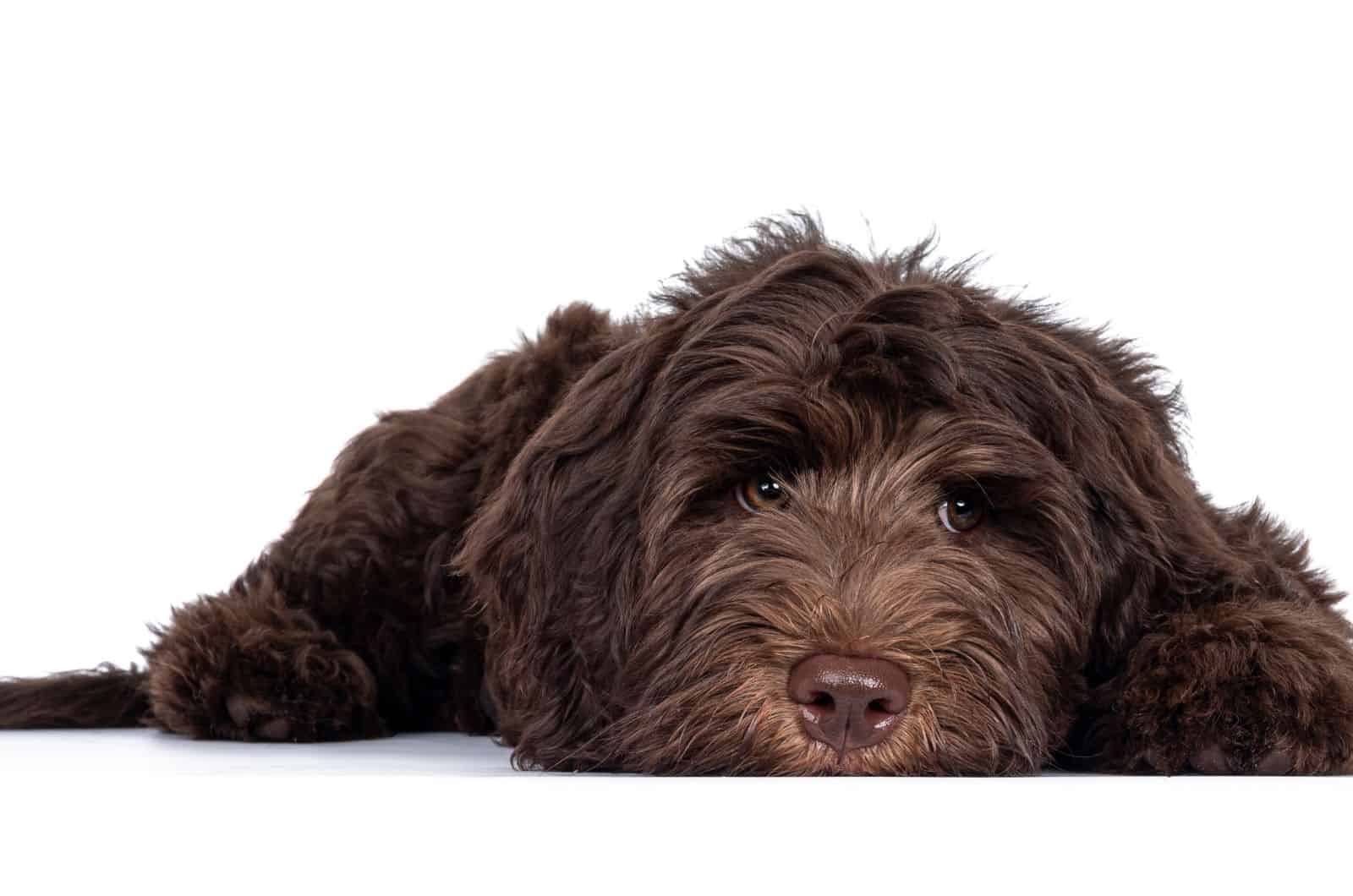
There are no known health issues that are the result of Labradoodles having a flat coat. They have the same predispositions and health risks that are associated with Curly-Haired Labradoodles, as well as Poodles and Labrador Retrievers.
There is nothing in the genetics of a straight-haired coat that would imply a greater risk of certain medical conditions. The lack of a Cu Locus that produces curly hair is only manifested in appearance and doesn’t seem to have any impact on a Labradoodle’s health.
What If I’m Allergic To Straight Hair Labradoodles?
If you find out that you are allergic to Straight Hair Labradoodles to an extent that you don’t feel well when you are around them, perhaps you should consider a different pet.
The thing is, the cause of allergies in humans does not come from the dog’s coat itself, but rather from particles that are known as “pet dander”. Dander refers to tiny bits of skin that are shed along with the hair throughout the year and they can be harmful to some people.
So even if you do something drastic like completely shaving your Straight Hair Labradoodle’s coat off — which you shouldn’t, as we’ve already established — you will not fix your allergies. In fact, you might even make them worse, since the dog will continue to shed even more once the coat starts growing back out, and there will be even more dander in the air.
If you are prone to allergies, we suggest that you opt for a Labradoodle that is genetically more similar to its Poodle ancestors, as their coats will not be a problem for you.
Straight Coat Labradoodle Price
Straight Hair Labradoodles are usually cheaper than their curly-haired counterparts, for reasons that we’ve already touched upon in this article.
Simply put, the non-shedding coat that curly-haired Labradoodles have because of their Poodle parents raises their price, leaving the flat-coated ones looking like a bargain.
On average, a Straight Hair Labradoodle puppy will cost you between $1,500 and $2,000, but they have also been known to sell for under $1,500 on occasion. Compare this to the prices of curly-haired puppies which sometimes go up to $3,000 and the difference is clear.
The Final Word
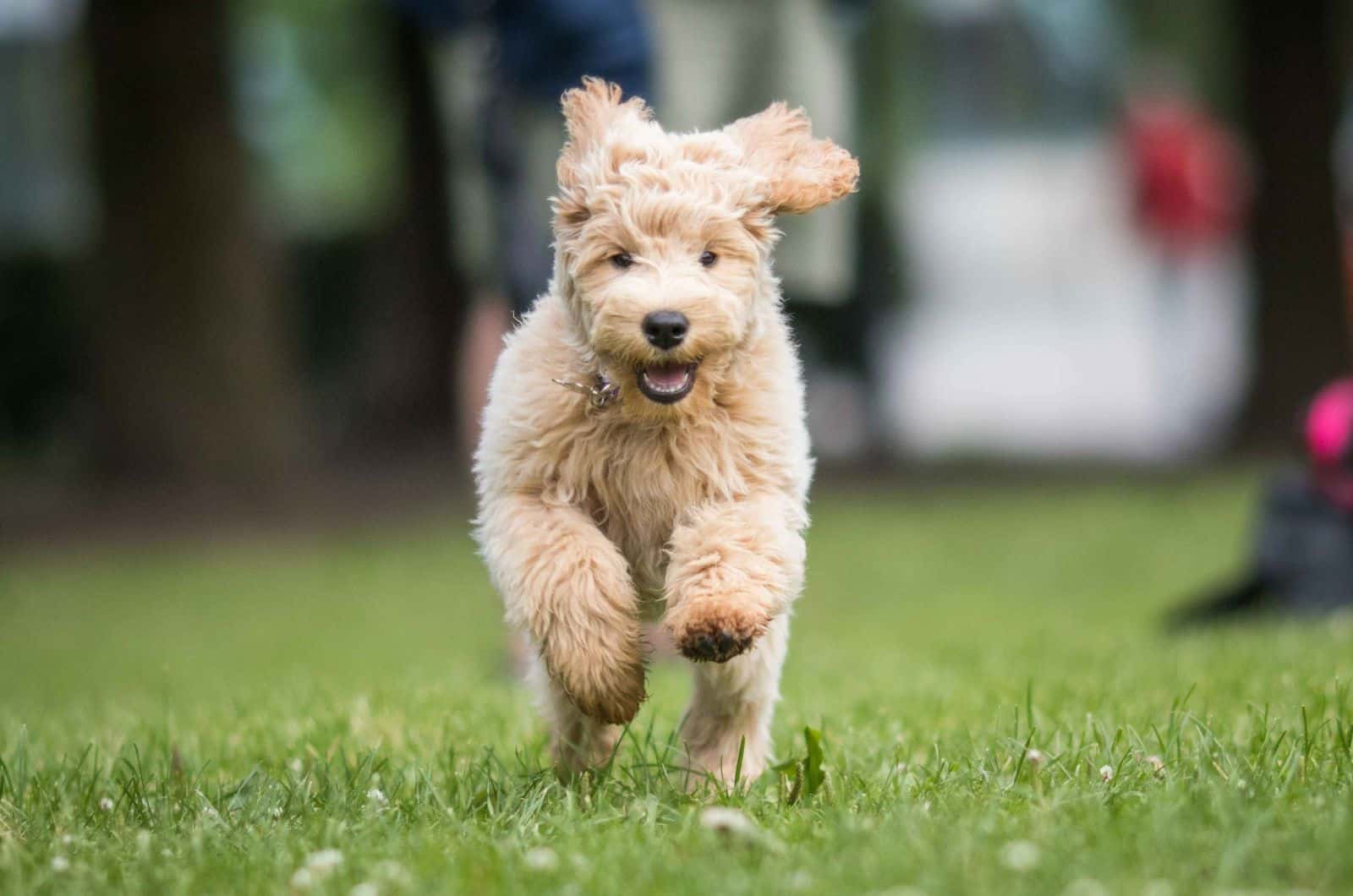
So, there you have it. The ultimate guide to the unique and adorable Straight Hair Labradoodle. If you were planning to adopt one of these pups, then this article will undoubtedly provide a great source of information for you.
Whenever you make the decision to adopt a dog, it’s important to prepare yourself in advance as much as you can and learn all the details about the particular breed you want to bring into your home. So, we tried to put together all the pros and cons of the Straight Hair Labradoodle, as well as all the traits and characteristics that make these dogs special.
Labradoodles are generally great pets, particularly if you have a family, because they enjoy companionship and spending time doing social activities. Flat Coat Labradoodles are no exception, in fact, you might even say that their prevailing Labrador Retriever genes make them even more friendly and playful.
So if you are hoping to bring one into your home in the near future, just make sure that you’ve done all the homework and also that you’ve chosen the best and most reputable breeder available to you. After that, you will have years of love and companionship from these shiny, fluffy pooches.
Read Next: The Labradoodle Feeding Chart And Healthy Diet Guide















